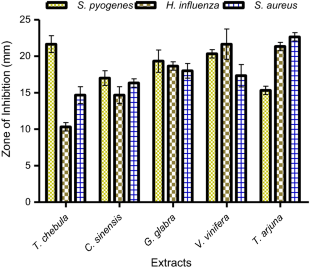Herbal antibacterial remedy against upper respiratory infection causing bacteria and in vivo safety analysis
Research Articles | Published: 11 August, 2021
Online ISSN : 2229-4473.
Website:www.vegetosindia.org
Pub Email: contact@vegetosindia.org
First Page: 264
Last Page: 268
Views: 1129
Keywords:
Streptococcus pyogenes, Haemophilus influenza, Staphylococcus aureus
, Upper respiratory tract infections, Antibacterial, Acute oral toxicity
Abstract
In the present study, the antibacterial activity and in vivo acute toxicity of five different extracts was analyzed. The Minimum Inhibitory Concentration and antibacterial activity of five different extracts, including Terminalia chebula, Camellia sinensis, Glycyrrhiza glabra, Vitis vinifera, and Terminalia arjuna, against three different bacterial species, namely, Streptococcus pyogenes, Haemophilus influenza, and Staphylococcus aureus was analyzed by broth dilution method and agar well diffusion method, respectively. The in vivo acute oral toxicity was analyzed by using Wistar rats. The antibacterial activity of different extracts was calculated by analyzing the zone of inhibition, and the maximum zone of 22 mm and minimum zone of 10 mm were observed against the different upper respiratory infections causing bacteria. The lowest MIC (0.8 mg/ml) found was of Camellia sinensis against the Streptococcus pyogenes and Staphylococcus aureus. No sign of toxicity and mortality was observed during the 14 days of study. The in vitro results of the tested extracts indicate that they possessed antibacterial activity and were found non-toxic. So, it can be used as an alternative for the treatment of upper respiratory infection-causing bacteria.

(*Only SPR Members can get full access. Click Here to Apply and get access)
References
Adeshina GO, Mshelia BM, Onaolapo JA (2014) Antibacterial susceptibility of Klebsiella pneumoniae isolated from respiratory tract infections to honey and lemon. Annu Res Rev Biol 4(4):625–637
Bardia A, Nisly NL, Zimmerman MB, Gryzlak BM, Wallace RB (2007) Use of herbs among adults based on evidence-based indications: findings from the National Health Interview Survey. Mayo Clin Proc 82(5):561–566. doi:https://doi.org/10.4065/82.5.561
Chan EW, Soh EY, Tie PP, Law YP (2011) Antioxidant and antibacterial properties of green, black, and herbal teas of Camellia sinensis. Pharmacogn Res 3(4):266–272. https://doi.org/10.4103/0974-8490.89748
Chen FP, Chen TJ, Kung YY, Chen YC, Chou LF, Chen FJ, Hwang SJ (2007) Use frequency of traditional Chinese medicine in Taiwan. BMC Health Serv Res 23:7:26. doi:https://doi.org/10.1186/1472-6963-7-26
Dwivedi S, Chopra D (2014) Revisiting Terminalia Arjuna—an ancient cardiovascular drug. J Tradit Complement Med 4(4):224–231. https://doi.org/10.4103/2225-4110.139103
El-Saber Batiha G, Magdy Beshbishy A, El-Mleeh A, Abdel-Daim MM, Prasad Devkota H (2020) Traditional uses, bioactive chemical constituents, and pharmacological and toxicological activities of Glycyrrhiza glabra L. (Fabaceae). Biomolecules 10(3):352. https://doi.org/10.3390/biom10030352
Goossens H, Ferech M, Vander Stichele R, Elseviers M, ESAC Project Group (2005) Outpatient antibiotic use in Europe and association with resistance: a cross-national database study. Lancet 365(9459):579–587. doi:https://doi.org/10.1016/S0140-6736(05)17907-0
Heinonen M (2007) Antioxidant activity and antimicrobial effect of berry phenolics a Finnish perspective. Mol Nutr Food Res 51(6):684–691. doi:https://doi.org/10.1002/mnfr.200700006
Kalia M, Singh D, Sharma D, Narvi S, Agarwal V (2020) Senna alexandriana mill as a potential inhibitor for quorum sensing-controlled virulence factors and biofilm formation in Pseudomonas aeruginosa PA. Pharmacogn Mag 16(72):802. https://doi.org/10.4103/pm.pm_315_20
Kaushik P (2019) Antibacterial potential of the Himalayan orchids. J Orchid Soc India 33:11–22
Kotwani A, Holloway K (2014) Antibiotic prescribing practice for acute, uncomplicated respiratory tract infections in primary care settings in New Delhi, India. Trop Med Int Health TM IH 19(7):761–768. https://doi.org/10.1111/tmi.12327
Kumar V, Abbas AK, Fausto N (2009) Aster Robbins and Cotran pathologic basis of disease, 8th edn. Saunders Elsevier, Philadelphia
Limsuwan S, Jarukitsakul S, Issuriya A, Chusri S, Joycharat N, Jaisamut P, Saising J, Jetwanna KW, Voravuthikunchai SP (2020) Thai herbal formulation “Ya-Pit-Samut-Noi”: its antibacterial activities, effects on bacterial virulence factors and in vivo acute toxicity. J Ethnopharmacol 259:112975. https://doi.org/10.1016/j.jep.2020.112975
Lipnick RL, Cotruvo JA, Hill RN, Bruce RD, Stitzel KA, Walker AP, Chu I, Goddard M, Segal L, Springer JA, Myers RC (1995) Comparison of the up-and-down, conventional LD50, and fixed-dose acute toxicity procedures. Food Chem Toxicol 33(3):223–231. doi:https://doi.org/10.1016/0278-6915(94)00136-c
Mandal S, DebMandal M, Pal NK, Saha K (2010) Antibacterial activity of honey against clinical isolates of Escherichia coli, Pseudomonas aeruginosa, and Salmonella enterica serovar Thypi. Asian Pac J Trop Med 3(12):961–964
Mohan L, Rao USC, Gopalakrishna HN, Nair V (2011) Evaluation of the anxiolytic activity of NR-ANX-C (a polyherbal formulation) in ethanol withdrawal-induced anxiety behavior in rats. Evid Based Complement Altern Med. https://doi.org/10.1155/2011/327160
Nassiri-Asl M, Hosseinzadeh H (2009) Review of the pharmacological effects of Vitis vinifera (Grape) and its bioactive compounds. Phytother Res 23(9):1197–1204. doi:https://doi.org/10.1002/ptr.2761
Nigam M, Mishra AP, Adhikari-Devkota A, Dirar AI, Hassan MM, Adhikari A, Belwal T, Devkota HP (2020) Fruits of Terminalia chebula Retz.: a review on traditional uses, bioactive chemical constituents and pharmacological activities. Phytother Res 34(10):2518–2533. doi:https://doi.org/10.1002/ptr.6702
Organization for Economic Co-Operation and Development (2001) The OECD guidelines for the testing of chemicals: 423. Acute Oral Toxicity- Acute Toxic Class Method
Passioti M, Maggina P, Megremis S, Papadopoulos NG (2014) The common cold: potential for future prevention or cure. Curr Allergy Asthma Rep 14(2):413. doi:https://doi.org/10.1007/s11882-013-0413-5
Pradhan S, Dubey RC (2020) Evaluation of phytochemical, antimicrobial and time-killing assay of Camellia species. Vegetos. https://doi.org/10.1007/s42535-020-00153-2
Said O, Khalil K, Fulder S, Azaizeh H (2002) Ethnopharmacological survey of medicinal herbs in Israel, the Golan Heights and the West Bank region. J Ethnopharmacol 83(3):251–265. doi:https://doi.org/10.1016/s0378-8741(02)00253-2
Vervloet M, Meulepas MA, Cals JW, Eimers M, van der Hoek LS, van Dijk L (2016) Reducing antibiotic prescriptions for respiratory tract infections in family practice: results of a cluster randomized controlled trial evaluating a multifaceted peer-group-based intervention. npj Prim Care Respir Med 26:15083. https://doi.org/10.1038/npjpcrm.2015.83
Acknowledgements
We are thankful to TEQIP for their support and the United Institute of Pharmacy (UIP) for allowing us to use their animal house facility. The authors acknowledge the Indian Council of Medical Research (ICMR) (AMR/ADHOC/184/2019-ECD-II) and DST-FIST grant to execute the work.
Author Information
Department of Biotechnology, Motilal Nehru National Institute of Technology, Allahabad, India
Department of Biotechnology, Motilal Nehru National Institute of Technology, Allahabad, India
vishnua@mnnit.ac.in